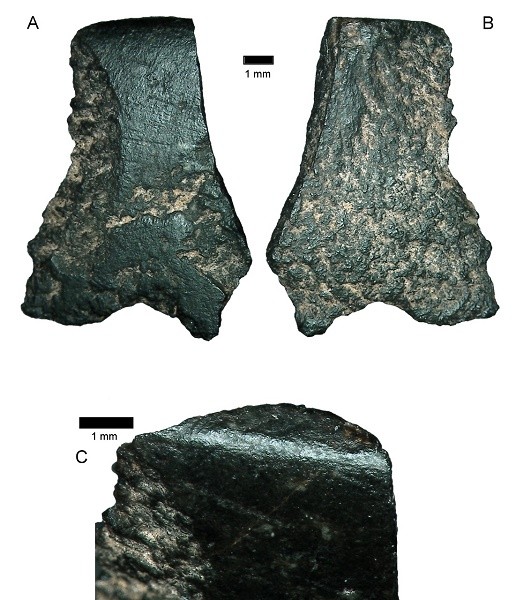World's First Axe Possibly Originated From Australia
| Ana Verayo | | May 11, 2016 05:14 AM EDT |
(Photo : University of Sydney/Australian Archaeology.) The world's oldest axe fragment, seen here under a microscope, is the size of a thumbnail
The world's oldest battle axe has apparently been unearthed in Australia, making this the first known blade to utilize a handle to add more power and force upon wielding it.
Researchers from several universities worldwide have identified this broken basalt shard which originated from a 49,000 to 44,000 year old axe. According to lead author of the study, Peter Hiscock from the University of Sydney, this axe is a possible technological innovation that was first used by the earliest Aboriginal settlers in Australia.
Like Us on Facebook
He explains that there are no known axes from Southeast Asia during the Ice age, which suggests that humans who first arrived in Australia began experimenting with new technologies, inventing ways to adapt to the new, Australian landscape and environment.
This type of axe is not only efficient for cutting wood and meat, but also as a weapon of war. Cutting stones were used as early as 700,000 years back, however, shaping a blade out of sharp stone, making an axe head and attaching a handle to it, represents a significant leap in the evolution of humans, signifying human intelligence.
When it comes to the origin and the evolution of mankind's first axe, archaeologists have been in the quest to determine the oldest one, where they discovered that axes uncovered in Australia were the oldest among other places.
In this new study, this polished basalt was discovered in the early 1990s by Australian National University's Sue O'Connor, during excavation work of an ancient rock shelter in Western Australia's northern region of Kimberley in Carpenter's Gap. It is also the first known site in the continent that has been inhabited by early humans.
This fragment was not examined and analyzed until 2014, where O'Connor says that these types of axes cannot be seen anywhere else especially dated this old. In Japan, similar axes are dated 35,000 years old, however, in most countries, they are dated around 10,000 years during the time when agriculture arrived and shaped modern civilizations.
Researchers believe that in order to shape this basalt shard into a sharp head along with a base that can support a handle, would require several days of hard work. This in turn makes the first axe something of high value, a precious tool and asset as well. Some fragments also appear to be flaked off after resharpening.
Even if the first axe technology could originate from Australia, knowledge of it did not spread among early Aboriginals beyond the north. Hiscock adds that colonizing groups may have abandoned the axe as humans spread out to deserts, in a more subtropical environment from tropical woodlands in the north.
This new study is published in the journal Australian Archaeology.
Tagsfirst axe in the world, Australia, world's oldest axe, Human evolution
©2015 Chinatopix All rights reserved. Do not reproduce without permission
EDITOR'S PICKS
-

Did the Trump administration just announce plans for a trade war with ‘hostile’ China and Russia?
-

US Senate passes Taiwan travel bill slammed by China
-

As Yan Sihong’s family grieves, here are other Chinese students who went missing abroad. Some have never been found
-

Beijing blasts Western critics who ‘smear China’ with the term sharp power
-

China Envoy Seeks to Defuse Tensions With U.S. as a Trade War Brews
-

Singapore's Deputy PM Provides Bitcoin Vote of Confidence Amid China's Blanket Bans
-

China warns investors over risks in overseas virtual currency trading
-

Chinese government most trustworthy: survey
-

Kashima Antlers On Course For Back-To-Back Titles
MOST POPULAR
LATEST NEWS
Zhou Yongkang: China's Former Security Chief Sentenced to Life in Prison

China's former Chief of the Ministry of Public Security, Zhou Yongkang, has been given a life sentence after he was found guilty of abusing his office, bribery and deliberately ... Full Article
TRENDING STORY

China Pork Prices Expected to Stabilize As The Supplies Recover

Elephone P9000 Smartphone is now on Sale on Amazon India

There's a Big Chance Cliffhangers Won't Still Be Resolved When Grey's Anatomy Season 13 Returns

Supreme Court Ruled on Samsung vs Apple Dispute for Patent Infringement

Microsoft Surface Pro 5 Rumors and Release Date: What is the Latest?










